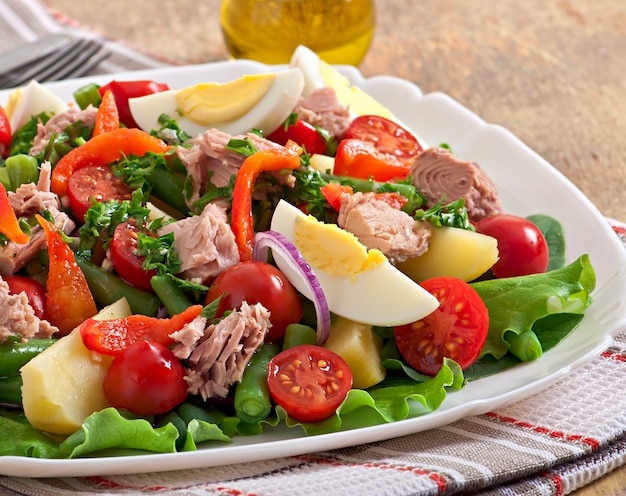What is the healthiest dressing to put on salad?
Salads are a popular choice for those seeking a healthy meal option, but the type of dressing used can significantly impact its nutritional value. While dressings add flavor and enhance the overall taste of a salad, they can also be high in calories, unhealthy fats, and added sugars. However, there are several options available that can provide both flavor and health benefits when drizzled over your greens.
When it comes to choosing the healthiest dressing for your salad, the key is to opt for options that are low in saturated fat, sugar, and sodium, while still providing essential nutrients and flavor. Here, we will explore some of the healthiest salad dressings you can consider adding to your greens.
The Benefits of Olive Oil-Based Dressings
Olive oil-based dressings, such as vinaigrettes, are often regarded as a healthy choice for salads. Olive oil is rich in monounsaturated fats, which have been shown to be heart-healthy and may help lower bad cholesterol levels. Additionally, it is a good source of vitamin E, an antioxidant that supports overall skin health.
Tasty and Nutritious Vinegar-Based Dressings
Vinegar-based dressings, like balsamic or apple cider vinegar, offer a unique tangy flavor while being low in calories and fat. These dressings are often made with a combination of vinegar, oil, and herbs, making them a healthier alternative to creamy dressings. Vinegar has also been linked to potential health benefits, including improved blood sugar control and reduced appetite.
Choosing Yogurt-Based Dressings for Creaminess
If you enjoy creamy dressings, choosing yogurt-based options can be a healthier alternative to mayonnaise or heavy cream-based dressings. Yogurt provides a good source of protein and calcium, while also offering probiotics that can support gut health. Opt for dressings that use unsweetened yogurt to avoid added sugars or artificial sweeteners.
Homemade Dressings for Full Control
Making your own salad dressings at home allows you to control the ingredients and ensure a healthier choice. By using basic ingredients like olive oil, vinegar, herbs, and spices, you can create delicious dressings without added preservatives or high levels of sodium. Experiment with different flavor combinations to suit your taste preferences.
“The key to choosing a healthy dressing is to look for options that are low in unhealthy fats, sugar, and sodium, while still providing flavor and essential nutrients.” – Registered Dietitian
Other Tips for a Healthy Salad
In addition to choosing a healthy dressing, there are a few other tips you can keep in mind to create a nutritious salad:
- Select a variety of colorful vegetables to incorporate different vitamins and minerals.
- Add a source of lean protein, such as grilled chicken or tofu, to make your salad more filling.
- Incorporate whole grains or legumes, like quinoa or chickpeas, for added fiber and sustained energy.
- Use nuts or seeds for a crunchy texture and a boost of healthy fats.
- Avoid adding excessive amounts of cheese, croutons, or bacon bits, as they can add unnecessary calories and unhealthy fats.
In summary, the healthiest dressing to put on your salad is one that is low in saturated fat, sugar, and sodium, while still providing flavor and essential nutrients. Olive oil-based dressings, vinegar-based dressings, yogurt-based dressings, and homemade dressings are all excellent choices to consider. Remember to experiment with different ingredients and flavors to find the perfect dressing that suits your taste buds and nutritional needs.
What can I put on salad instead of dressing?
1. Healthy Alternatives:
Dressing is often used to add flavor and moisture to salads, but if you’re looking for a healthier alternative, consider these options:
- Extra Virgin Olive Oil: Drizzle a little bit of olive oil over your salad for a touch of richness and healthy fats.
- Balsamic Vinegar: Add a splash of balsamic vinegar to your salad for tanginess without the extra calories.
- Lemon Juice: Squeeze fresh lemon juice over your salad to give it a bright and refreshing flavor.
- Greek Yogurt: Mix Greek yogurt with a dash of herbs or spices for a creamy and low-fat dressing alternative.
2. Flavorful Toppings:
If you want to add more flavor to your salad without relying on dressings, try these tasty toppings:
- Crumbled Feta Cheese: Sprinkle some crumbled feta cheese over your salad for a tangy and salty kick.
- Toasted Nuts: Add a handful of toasted nuts, such as almonds or walnuts, for crunch and extra protein.
- Dried Fruits: Mix in dried fruits like cranberries or raisins to add a hint of sweetness to your salad.
- Herbs and Spices: Experiment with different herbs and spices like basil, cilantro, cumin, or paprika to enhance the flavors of your salad.
3. Light Dressing Options:
If you still prefer a dressing-like consistency, consider these lighter options:
Yogurt-Based Dressings: Opt for yogurt-based dressings that are lower in calories and fat compared to traditional dressings.
Mustard-Based Dressings: Mustard-based dressings can provide tanginess without adding excessive calories.
Remember, salads don’t have to be boring! Experiment with different combinations of ingredients and toppings to find what works best for your taste preferences and dietary needs.
What primary ingredient is used in most salad dressing?
Salad dressings are an essential part of enjoying a delicious and healthy salad. They add flavor, texture, and moisture to otherwise plain vegetables. While there are various types of salad dressings available, one primary ingredient can be found in most of them – oil.
Oil serves as the base for many salad dressings due to its ability to bind with other ingredients and enhance their flavors. It provides a smooth and creamy consistency while also acting as a carrier for other flavors. The most commonly used oils in salad dressings are olive oil, canola oil, and vegetable oil.
The Importance of Oil in Salad Dressings
Oil acts as a flavor enhancer in salad dressings, bringing out the natural tastes of the ingredients it is mixed with. It also helps to evenly distribute the flavors throughout the salad. Moreover, oil adds a luscious mouthfeel and helps to coat the salad leaves or vegetables, giving them a desirable texture.
“Oil is the magic ingredient that brings all the components of a salad dressing together.” – Chef Julia Child
Types of Oil Used in Salad Dressings
The choice of oil can greatly impact the taste and health benefits of a salad dressing. Olive oil, with its rich and fruity flavor, is a popular choice. It pairs well with Mediterranean-inspired salads and can be extra virgin or regular. Canola oil, on the other hand, has a more neutral taste and is often used in dressings where the flavor of other ingredients needs to shine through.
Apart from olive and canola oil, other options like vegetable oil, avocado oil, and sesame oil can also be used depending on the desired flavor profile. It is always good to experiment with different oils to find your favorite combination.
Making Your Own Salad Dressings
Creating your own salad dressings at home can be simple and rewarding. By using high-quality oil, fresh ingredients, and a few basic pantry staples, you can customize your dressings to suit your taste. Here’s a simple recipe to get you started:
- In a bowl, whisk together 1/4 cup olive oil, 2 tablespoons balsamic vinegar, 1 teaspoon Dijon mustard, and a pinch of salt and pepper.
- Adjust the seasoning according to your preferences.
- Pour the dressing over your favorite salad and toss until well coated.
By understanding the importance of oil as the primary ingredient in most salad dressings, you can elevate your salads with homemade creations that are flavorful, nutritious, and tailored to your liking.
What is the number 1 salad dressing?
When it comes to salad dressings, there are countless options available on the market. From creamy classics like ranch and caesar to tangy vinaigrettes and zesty Italian dressings, choosing the right one can be a tough decision. However, there is one salad dressing that consistently ranks as the number one choice for many people: balsamic vinaigrette.
The Versatility of Balsamic Vinaigrette
Balsamic vinaigrette is a classic dressing that originates from Italy. Made with a combination of balsamic vinegar, olive oil, and various seasonings, it offers a perfect balance of sweetness and tanginess. What makes it the number one choice for salad lovers is its versatility. Whether you’re tossing together a simple green salad or creating a more complex dish with fruits, cheese, and nuts, balsamic vinaigrette complements a wide range of ingredients.
The Health Benefits of Balsamic Vinaigrette
In addition to its delicious taste, balsamic vinaigrette also offers several health benefits. Balsamic vinegar is rich in antioxidants, which can help combat inflammation in the body. Olive oil, another key ingredient in this dressing, is packed with heart-healthy monounsaturated fats. These fats can help reduce bad cholesterol levels and promote good heart health when consumed in moderation.
How to Use Balsamic Vinaigrette
There are numerous ways to use balsamic vinaigrette in your meals. Here are a few ideas:
- Drizzle it over a fresh caprese salad with tomatoes, mozzarella cheese, and basil.
- Toss it with mixed greens, strawberries, and goat cheese for a refreshing summer salad.
- Use it as a marinade for grilled vegetables or chicken.
- Drizzle it over roasted vegetables for added flavor.
“Balsamic vinaigrette adds a burst of flavor to any salad or dish. Its versatility and health benefits make it the number one choice for many.” – Chef Emma
The Final Verdict
While everyone’s taste preferences differ, balsamic vinaigrette consistently stands out as the number one salad dressing choice for its versatile flavor profile and health benefits. Whether you prefer store-bought bottles or enjoy making your own at home, this classic dressing is a must-try for any salad enthusiast.



